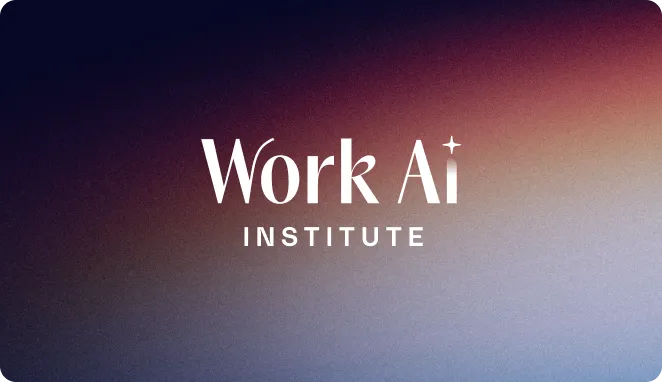We’ve entered the agentic era. AI is now capable of advanced reasoning and executing complex tasks. Over the past couple of years, most of us have experimented with AI at home and at work, finding ways to save time or replace tasks with AI. While we’ve seen some time-saving benefits, we’ve only just scratched the surface of what’s possible. Now, thanks to the growing intelligence of models combined with a unified agent platform and employee creativity, new ways of working enable us to save time and rethink how we work in ways that weren’t possible pre-AI.
At Glean, we’re already seeing agentic AI impact the way we scale our company. For example, Glean employees use apps, agents, assistants, and chatbots that enable:
- Glean product managers to analyze thousands of customer calls to inform our product roadmap, helping us to stay close to the ever-evolving customer needs at scale.
- Our engineers to automatically review and document PRs
- Our sales teams to arrive at customer meetings with a better understanding of the customer and industry, and can answer questions and solve problems in the moment, making the most of the customer’s time.
There are many more examples, but the gist stays the same—agentic AI, when knowledgably directed by our employees, enables Glean to achieve strategic business impact rather than just incremental time savings.
Despite much industry talk of replacing humans with AI agents, I’ve seen firsthand with both our customers and employees that AI is at its best when assisting humans. For example, our customers at:
- Zillow developed a career growth analysis agent. This agent helps employees analyze their performance evaluations and growth opportunities and outlines what they need to do to advance to the next job level
- Miro personalized sales outreach, resulting in more targeted messages and 80% less time spent on generating emails
- Deutsche Telekom rolled out an employee concierge to 80k+ employees that automates IT and HR requests using natural language
This is just a small sliver of the 50M+ agentic actions that customers have executed across their organizations in the past year with Glean.
Today, we’re proud to be taking one step further into the agentic era with the launch of Glean Agents— Glean’s horizontal agent environment for building, deploying, orchestrating, and governing agents at work. With Glean Agents, everyone can easily build and use agents, and companies can manage and govern thousands of agents, helping enterprises embrace AI in a compliant, secure way at scale. We’re also introducing several new platform capabilities integrated into Glean Agents:
- Universal knowledge accesses data from both company apps and databases, as well as information from the web and LLM data, to research, analyze insights, make decisions, and automate work
- Structured data analysis enables everyone to make data-driven decisions by querying live data from structured data applications, such as Salesforce, Databricks, and Jira, using natural language
- Active data and AI governance continuously scans and auto-hides overshared sensitive data across all enterprise applications, giving companies another layer of control over the data used for AI

Glean Agents — build and use agents using natural language
Glean Agents is the horizontal environment for everyone to create, use, and share agents. We don’t relegate agents just to developers with backgrounds in AI and the skills to integrate agents with databases, APIs, and other enterprise platforms. We see the most gains from agents when users can create them in minutes, or when they’re automatically triggered based on the user’s query. Agents are also best built by the users themselves—those closest to understanding specific business processes are best fit to capture and automate them.
With this approach in mind, we built Glean Agents to scale across the enterprise. Agents are powered by Glean’s LLM-agnostic agentic reasoning engine and have access to enterprise and world knowledge and a suite of orchestrated actions.
Glean Assistant provides an out-of-the-box, company-wide agent experience that everyone can use, and for employees who want to build their own agents, getting started is simple. Users only need to provide a few lines of text describing their desired goals to have the natural language agent builder begin creating an agent. For example, let’s say my product management team wants to build an agent to help understand the most frequent feature requests for the company this quarter. They input the query and the agent builder creates a fully-formed and functioning agent. Of course, if deeper customization is necessary, users can manually adjust it and provide additional instructions to fit their preferences.
Once created, agents can be saved, scheduled, or triggered based on a wide range of conditions. They can be shared with the wider organization through Glean’s agent library, enabling users to explore and experiment with agentic AI. Glean will also proactively recommend agents to users based on their interactions with Glean Assistant, integrating agents into the way they already use Glean every day.
Today, most enterprises have hundreds of SaaS applications. I see enterprises deploying 10x or 100x that number of agents tomorrow. You’ll need the tools to orchestrate at scale, giving agents the feedback to improve and putting in place the guardrails to keep your agents compliant. This is where the value of Glean Agents emerges for companies—making it easy to both create and govern agents at scale in the enterprise.
Read more about Glean Agents and how to get started with creating an agent in this blog.
Universal knowledge—broad, real-time data access for Work AI
At work, we often switch between using internal and external data. For example, creating a sales campaign requires using customer data and external information on prospects and industry trends. Similarly, designing an engineering feature requires considering the tech stack and best practices from other developers. While automating most business processes use internal tools and data, strategy and insights come from both internal and external data.
That’s what makes the launch of universal knowledge so useful for customers—Glean can now provide the broadest and most comprehensive set of knowledge for work AI. Users can combine enterprise data with internet data, enabling the integration of online information such as real-time industry insights and current market conversations directly into Glean queries. Users looking to learn more about a subject beyond the response provided can also explore deeper or wider, regardless of source, using citations to the source material.
Read more about Glean’s universal knowledge capabilities and how to integrate it into everyday workflows in this blog.
Structured data analysis—democratizing access to data insights
When it comes to leveraging all the data in the enterprise, however, structured data is a piece of the puzzle that most AI solutions have yet to crack. Although generative AI unlocked access to unstructured data within companies (context and meaning from words), these models were not designed for structured data that contains predefined schemas, relationships between columns and rows, as well as understanding interconnectedness between underlying tables and materialized views.
With this release, Glean’s universal knowledge capabilities are now compatible with both structured and unstructured data, enabling users to bring data to every decision using simple natural language queries. Glean supports structured data analysis by understanding the schema of databases, including data lakes and warehouses like Databricks and applications like Salesforce or Jira. Users can ask ad hoc questions of their data, visualize their data in charts and diagrams, and drill down into the results, helping users traverse from understanding high-level trends to data nuances for quality decisionmaking.
.gif)
When people think of agents, they usually focus first on task or business process automation and forget the role they play in democratizing data insights across the enterprise. Data analysis is a key for agents to reshape business processes, making it simpler for both people and agents to access the data needed to make better data-driven decisions. With universal knowledge, we also help bring all data—enterprise and internet, historical and real-time, structured and unstructured—into every decision, ending a multi-decade long journey to data accessibility.
Read more about Glean’s structured data analysis capabilities in this blog.
Active data and AI governance—proactive flagging of overshared data
To maximize AI's potential, agents rely on broad access to enterprise data and the ability to take actions across business applications. However, broad data access introduces significant risks that must be carefully managed. Even with stringent security measures, their effectiveness is directly set by permissions set by the users themselves. Therefore, while enforcing permissions is crucial, it is not sufficient on its own—the platform itself must be capable of detecting permission errors that lead to over-shared content and automatically block or remediate these issues.
To tackle this, we’re introducing a new layer of governance, active data and AI governance, which proactively protects enterprises against new and emerging risks when bringing agents into the enterprise.
What we’ve heard from many companies adopting Glean is that application and data sprawl has inadvertently left their organization operating with ‘security through obscurity’ or a reliance on data being hard to find to achieve security. Rather than wait on a multi-year permissions and retention cleanup effort, Glean enables companies to actively scan and remediate accidentally overshared information today so they are capable of moving forward with integrating AI into the enterprise.
Whether to protect trade secrets, financial data, or customer data, Simply set policies customized to your organization and Glean will remediate within its application. We want to help enterprises securely accelerate AI adoption, and our active governance capabilities, spanning over 100+ applications, provide broad coverage for horizontal work AI.
Active governance is one layer in our modern approach to security and governance, sitting on top of fine-grained indexing controls and a unified permissions framework to protect enterprise data for AI adoption.
Read more about Glean’s active data and AI governance capabilities and how it deploys into the enterprise in this blog.
Work AI for the agentic era
We’ll be working differently in the age of agents, but that change has to happen organically. It all starts with employees using AI to improve their daily productivity, reshape business processes, and lead company-wide innovation. That revolutionary AI transformation where everyone can use and build new agents requires everyone to have direct access. However, without the right environment that enables everyone to build, manage, and share agents safely, getting started with AI can be a slow and risky process.
Today, the launch of Glean Agents, universal knowledge, structured data analysis, and active data and AI governance gives every employee and every organization the ability to use, share, manage and govern agents at scale. By infusing Glean Agents into our product experience, we’re providing the many users who query Glean ~5x a day an easy way to directly experiment with and integrate agents into their everyday work.
You can discover more about Glean Agents and our new platform capabilities, at Glean Live: Winter ‘25 launch event. I’ll be onstage along with Toby Roberts of Zillow, Adam Conway of Databricks, our very own Tamar Yehoshua and many more for live demos and fireside chats—I hope you’ll join us.









